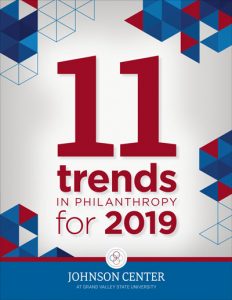The Boundaries Are Blurring Between Philanthropy and Business


 became the latest major philanthropists to commit to a new way of giving. Like Mark Zuckerberg and Priscilla Chan, Laurene Powell Jobs, and Pierre Omidyar before them, the Arnolds have decided to restructure their giving through a charitable LLC, Arnold Ventures, that will combine the principles of business and philanthropy in a way they hope will increase their impact and quicken the pace of change.
became the latest major philanthropists to commit to a new way of giving. Like Mark Zuckerberg and Priscilla Chan, Laurene Powell Jobs, and Pierre Omidyar before them, the Arnolds have decided to restructure their giving through a charitable LLC, Arnold Ventures, that will combine the principles of business and philanthropy in a way they hope will increase their impact and quicken the pace of change.
This move reflects a larger trend within philanthropy that looks beyond traditional sector borders to find innovative solutions to some of society’s most intractable challenges. Dr. Michael Moody explores the thinking behind strategies like Arnold Ventures — their potential achievements and potential pitfalls — in this piece from our 11 Trends in Philanthropy for 2019 report.
Download and read the full report, featuring all 11 trends, here.
For as long as we have used “sectors” to define society, we’ve been particularly fixated on the boundaries between those sectors, often letting those boundaries define the sectors themselves — why else use the odd term, “nonprofit?”
Advocates for one sector or another have often warned about the blurring of these boundaries. Proponents of philanthropy have cautioned against the dangers of becoming too “businesslike” and prioritizing profit over purpose (McCambridge, 2015). True believers in capitalism, like Milton Friedman, insisted that the genius of the free market would be undermined if businesses added “social responsibility” to their bottom line (Friedman, 1970).
But today, the increasing blurriness of sector boundaries is undeniable, and more and more people are embracing the potential good that more open sector borders might create. This is especially true for the boundary between for-profit and nonprofit, between the business and philanthropic sectors.
More nonprofits are looking for profitable revenue streams and borrowing business jargon and tactics. More donors are talking about their giving and grantmaking as “social investing,” and are conducting “due diligence” on these investments. On the corporate side, Milton Friedman is rolling in his grave as “corporate social responsibility” is becoming a requirement for businesses of all sorts. Even Super Bowl ads are touting each company’s charitable or environmental commitments as much as the quality of their products (Schultz, 2018). If you aren’t a double- or triple-bottom-line company, you can’t compete anymore.
“Perhaps most telling is the rise of so-called ‘hybrid’ organizations, which are often legally organized as for-profit, but which are officially committed to social purposes.”
Perhaps most telling is the rise of so-called “hybrid” organizations, which are often legally organized as for-profit, but which are officially committed to social purposes. While Ben and Jerry’s were pioneers in this space three decades ago, “B Corps” like Patagonia are now the norm (Ben & Jerry’s, 2018). Social entrepreneurs with a passion for a cause are often choosing to create “social enterprises” instead of traditional nonprofits.
One of the most notable developments in the philanthropic world in the last decade was the decision by Mark Zuckerberg and Priscilla Chan to use a for-profit entity — a “charitable LLC” — to channel their vast fortune for the public good. Like many young people, they are “sector agnostics;” they believe good can arise from any sector, not just from nonprofits (Buchanan, 2017). This same way of thinking is behind the incredible rise in “impact investing.” Trying to create solely financial or solely philanthropic value is now considered by many to be ineffective and old-school. Our new blurry world instead creates what Jed Emerson calls “blended value” (Bugg-Levine and Emerson, 2011).
In short, philanthropy is increasingly adopting business means, while business is increasingly pursuing philanthropic ends. Of course, this is not a completely new phenomenon. Goodwill has used business means since 1902, and John D. Rockefeller argued that the “best philanthropy” was providing good jobs (Rockefeller, 1908). What is new is just how widespread and socially legitimate this blurriness is.
This trend is likely to continue and expand, in part because millennials are big fans of it. They want to work for and buy the products of socially responsible companies — even if it means making less money or spending more. And they don’t get why nonprofits should avoid money-making ventures just to remain “pure.” They’ve grown up in a world where mission and money-making have often been dual purposes, co-existing in harmony.
It is hard to deny the positive aspects of this trend. Innovations from business can lead to more efficiency in philanthropy, and a more socially responsible corporate sector is undoubtedly a good thing. However, the potential downsides here are worth paying more attention to as well (Ganz, et al., 2018; Daniels and Koenig, 2017).
All in all, two things are certain:
Otherwise, generations in the future might just think of philanthropy as one type or one function of business. We will have lost something special if that happens.
Barman, E. (2016). Caring capitalism: The meaning and measure of social value. Cambridge University Press.
Ben & Jerry’s. (2018). Our history: The 1980s. Retrieved from https://www.benjerry.com/about-us#2timeline
Buchanan, P. (2017, March 23). Losing our religion: Against sector agnosticism [Blog post]. Retrieved from https://cep.org/losing-religion-sector-agnosticism
Bugg-Levine, A. & Emerson, J. (2011). Impact Investing: Transforming How We Make Money While Making a Difference. San Francisco, CA: Jossey-Bass.
Daniels, A., & Koenig, R. (2017, December 5). How new forms of philanthropy are squeezing traditional charities. The Chronicle of Philanthropy, 30(2). Retrieved from https://www.philanthropy.com/article/How-NewForms-of-Philanthropy/241883
Friedman, M. (1970, September 13). A Friedman doctrine: The social responsibility of business is to increase its profits. The New York Times, p. SM17. Retrieved from https://search.proquest.com/docview/117933451?accountid=39473
Ganz, M., Kay, T., & Spicer, J. (2018, Spring). Social enterprise is not social change. Stanford Social Innovation Review. Retrieved from https://ssir.org/articles/entry/social_enterprise_is_not_social_change
McCambridge, R. (2015, May 15). Why the nonprofit sector should worry about sector blurring. Nonprofit Quarterly. Retrieved from https://nonprofitquarterly.org/why-the-nonprofit-sector-should-worry-about-sector-blurring/
Rockefeller, J. D. (1908, October). Some random reminiscences of men and events. The World’s Work, 16(6), 10755–10767. Retrieved from https://books.google.com/books?id=0p06AQAAMAAJ&dq=the%20world’s%20work%20volume%2016%201908&pg=PP5
Schultz, E. J. (2018, January 29). Why more Super Bowl ads are touting philanthropy. AdAge. Retrieved from https://adage.com/article/special-reportsuper-bowl/super-bowl-ads-hyundaibudweiser-philanthropic-bent/312121